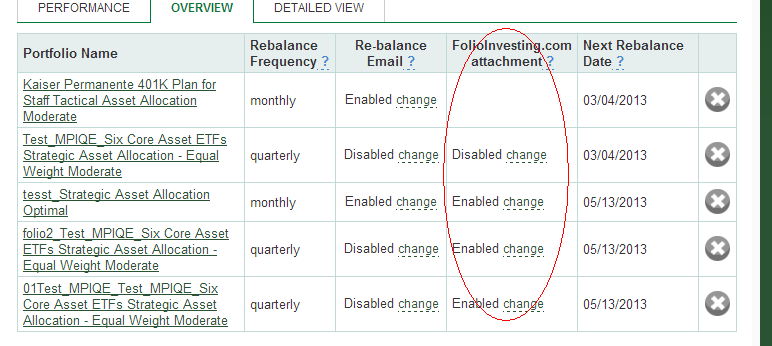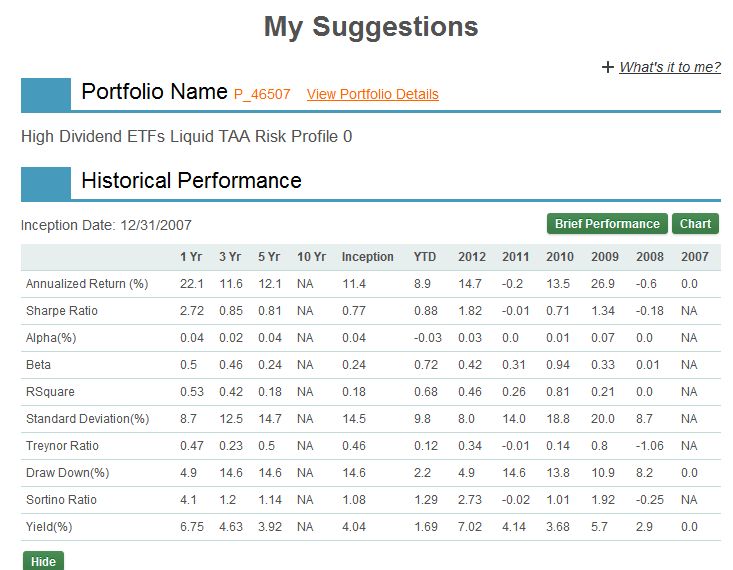New Features
In this newsletter, we discuss a few new features that were released recently. We believe they are of interests to many users.
Portfolio One-Click Rebalance on FolioInvesting.com
We recognize the importance of ease of use for many users. This is especially true for users to implement our portfolios in their actual brokerage or 401k accounts. In previous newsletter April 22, 2013: Portfolio Rebalance – Ease of Use, we described in some details on how to implement a MyPlanIQ portfolio in a FolioInvesting.com account. To recap, we mentioned two methods:
- Method 1: You can follow one of 10 pre-configured folios from MyPlanIQ Diversified Core Allocation ETF Plan, 5 for SAA-Equal Weight (free, listed on Folio’s Ready to Go folio page) and 5 for TAA.
- Method 2: For any other MyPlanIQ portfolio you intend to implement on FolioInvesting.com, we showed a step by step process for you to download Excel CSV target allocation file and upload to your account on FolioInvesting.com to rebalance.
We are pleased to announce that we now make it even easier for you to follow a portfolio on FolioInvesting.com for Method 2: for any ETF or mutual fund portfolio we deem to be implementable on FolioInvesting.com, we now will ask you whether you would like to have the portfolio target allocation Excel CSV spread sheet attached each time when rebalance instructions for this portfolio are sent to you in an email.
There are 3 ways to do so:
- Customize a portfolio: it will ask you whether to elect receiving the FolioInvesting format CSV attachment in this portfolio’s rebalance email.
- Get Started Now: this is similar to Customize a portfolio.
- On Dashboard, you can elect whether a portfolio to receive FolioInvesting attachment or not.
The following shows the Dashboard usage:
Please note that since mutual fund based portfolios are very much limited to specific brokerages due to availability and transaction fee (or non transaction fee) issues, most of the above are really only usable for ETF based portfolios such as those listed on Overview & Featured ETF Portfolios or Lazy Portfolios.
We are developing mutual fund based portfolios for FolioInvesting.com. We will make announcement in the future newsletter.
We believe with such helpful info, a user can implement his/her FolioInvesting account re-balance practically in 10 minutes or so.
Portfolio Dividend Data
In the previous newsletter May 6, 2013: High Dividend ETF Portfolio Construction, we announced that we are working on high dividend ETF based portfolios. Many users have asked for the portfolio’s historical data. We now make this data available.
For example, on the page of High Dividend ETFs Liquid TAA Risk Profile 0 mentioned in the previous newsletter, you can click on ‘More Performance Analytics’ button or when you view one of your portfolios through Dashboard by clicking on a portfolio link, you can click on ‘View Performance’ and then ‘Detailed Performance’, that will reveal historical Yield (or dividend) data such as the following
Please note that Portfolio Yield in a trailing N years is calculated as
Total Dividends or Distributions Collected in Portfolio P in the trailing N years/(Today’s Total Amount of Portfolio P * N)
This is similar to the standard way to calculate last 12-month dividend yield or distribution for a mutual fund or ETF.
Change A Static Portfolio Dynamically
A feature in Static Portfolios (you can use this feature on the left panel of your Dashboard) allows you to update a static portfolio as time goes while keeping the historical performance intact. With this feature, you can use a Static Portfolio to keep track of your actual investment brokerage account or just keep track of a model portfolio that you change its allocations or holdings along the time.
To do so, click on a static portfolio on your Dashboard->Static Portfolios and then ‘Change Portfolio’ on the portfolio page, enter the new allocations on the input box and click on ‘Save & Apply’. This will make the change only effective starting today while still keeping the portfolio’s history. See the following figure:
Portfolio Performance Review
The following table shows two advanced portfolios available on our Advanced Strategies page:
Portfolio Performance Comparison (as of 5/20/2013)
| Ticker/Portfolio Name | 1 Week Return* |
YTD Return** |
1Yr AR | 1Yr Sharpe | 3Yr AR | 3Yr Sharpe | 5Yr AR | 5Yr Sharpe | 10Yr AR | 10Yr Sharpe |
|---|---|---|---|---|---|---|---|---|---|---|
| SPY | 2.2% | 17.7% | 30.4% | 2.39 | 16.0% | 0.89 | 5.4% | 0.2 | 7.9% | 0.33 |
| P Calendar Based Trading RUT | 2.5% | 17.5% | 29.3% | 1.96 | 14.6% | 0.61 | 7.0% | 0.28 | 7.6% | 0.34 |
| STS Seasonal Timing Using DWC | 2.0% | 15.8% | 13.4% | 1.53 | 12.2% | 1.14 | 7.8% | 0.52 | 6.2% | 0.4 |
*: NOT annualized
**YTD: Year to Date
latest and detailed comparison >>
The above two advanced portfolios are based on some popular Wall Street folklore. Their performance has been erratic in the past. It is interesting to point out how their recent performance has been changed in this unprecedented central bank induced rally:
- The Calendar based trading portfolio had under performed dramatically until mid last year. It then rallied back.
- On the other hand, the STS seasonality portfolio did much better than stock market index such as SPY but again, since last year, it was gradually caught up by SPY.
- Nevertheless, both portfolios had much smaller maximum drawdowns in the past 5 years (all incurred in 2008-2009) compared with SPY: SPY — 52%, Calendar Trading — 32% and STS Seasonal — 27%.
The takeaway here is that consistent implementation is the key to investment success, being buy and hold (just hold SPY) or some sort of active strategies. However, one should definitely understand and research each investment strategy’s behavior (including its pros and cons) thoroughly before committing to it. Because of the nature of investing, committing to a strategy means committing to it for a long enough period of time.
Market Overview
The overall major asset trends have not changed: the uniform risk on mode persists: all major stock assets including emerging market stocks remain above US bonds in the major asset trend ranking table on Asset Trends & Correlations (for other detailed ranking, see 360° Market Overview). Commodities and gold are still at the bottom, indicating a weak pricing environment or something else?
Though we have been cynical on the markets because of weak fundamentals, we stick to our practical strategies, fully understanding their weakness and/or possible upcoming loss as described in our previous newsletter May 13, 2013: Preparing To Take A Loss. Again, our own reasoning will serve us well in terms of overall portfolio planning, especially when we are dealing with new money or switching to a new strategy but once the portfolios are fully in place, we need to fully stick to their planned strategies for a long time to see their benefits.
We again copy our position statements (from previous newsletters):
Our position has not changed: We still maintain our cautious attitude to the recent stock market strength. Again, we have not seen any meaningful or substantial structural change in the U.S., European and emerging market economies. However, we will let markets sort this out and will try to take advantage over its irrational behavior if it is possible.
We again would like to stress for any new investor and new money, the best way to step into this kind of markets is through dollar cost average (DCA), i.e. invest and/or follow a model portfolio in several phases (such as 2 or 3 months) instead of the whole sum at one shot.
Latest Articles
- Social Security Earnings Penalty?
- Tom Dorsey: ‘ETF Alchemy’ Is The Future
- The Meaning of the New Highs in the S&P500
- Tax Rate Reminder
- Amazon Sales Tax Collection: Coming To Your State Soon!
- From the Archives: Life Expectancy at Retirement
- Investment Risk Re-imagined
- Going to alternatives for yield
- PIMCO’s Big Picture: Dialing Down Risk
- May 13, 2013: Preparing To Take A Loss
Enjoy Newsletter
How can we improve this newsletter? Please take our survey
–Thanks to those who have already contributed — we appreciate it.




